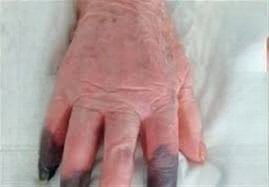Most people tend to brush off small cuts, scratches, or insect bites as minor inconveniences. A quick rinse with water, maybe a bandage, and it’s back to daily life. Yet, medical experts consistently warn that even the smallest wound has the potential to develop into something far more dangerous if left untreated.
Recent reports of a blackened and swollen hand shared across health forums and news outlets serve as a stark reminder: minor injuries are not always harmless. What begins as a small sting or bite can sometimes evolve into a severe infection, potentially leading to tissue damage, hospitalization, or worse.
This article explores the hidden risks of untreated minor injuries, the medical conditions they may trigger, how to recognize danger signs early, and the steps you can take to protect yourself and your loved ones.
Why Minor Injuries Deserve Attention
It is easy to underestimate the risk that comes with a small wound. A child’s scraped knee, a gardener’s thorn prick, or an insect sting during summer may appear trivial. However, beneath the skin, bacteria and toxins can spread rapidly.
Openings in the skin act as gateways for harmful microorganisms. If the body’s immune system cannot contain the threat, infections develop. In rare but severe cases, these infections progress so aggressively that urgent medical intervention becomes necessary.
Ignoring the early warning signs is often the difference between a full recovery and long-term complications.
Common Triggers That Turn Harmless Injuries Dangerous
Several factors can turn an everyday cut or insect bite into a medical emergency. Some of the most common include:
1. Venomous Spider or Insect Bites
Certain spiders, like the brown recluse or black widow, inject venom that damages tissues and disrupts blood flow. In sensitive individuals, even bee or wasp stings can result in severe swelling or infections if not properly treated.
2. Bacterial Infections
Bacteria such as Staphylococcus aureus or Streptococcus pyogenes can enter through cuts, scrapes, or puncture wounds. Left unchecked, they may cause cellulitis, abscesses, or more severe complications like necrotizing fasciitis (sometimes referred to as “flesh-eating disease”).
3. Exposure to Contaminated Environments
Cuts sustained while swimming in lakes, working in soil, or handling unclean surfaces are especially risky. Harmful bacteria thrive in warm, moist, or dirty environments, increasing infection risks.
4. Weakened Immunity
People with chronic illnesses—such as diabetes, cancer, or autoimmune conditions—have reduced ability to fight infections. A small wound that might heal quickly in a healthy individual can escalate rapidly in someone with a weakened immune system.
5. Delayed or Improper Wound Care
Failing to clean and cover a wound promptly allows bacteria to multiply. Using non-sterile home remedies or ignoring symptoms can worsen the condition.
What Can Happen If Infections Are Ignored
When untreated, infections can progress from mild discomfort to life-threatening emergencies. Potential complications include:
- Tissue necrosis (death): Blood supply is cut off, leading to blackened skin and loss of function.
- Sepsis: A severe infection spreads into the bloodstream, causing organ damage.
- Osteomyelitis: Bacteria reach the bone, requiring long-term treatment.
- Amputation: In extreme cases, to save a patient’s life, doctors may have to surgically remove the infected limb.
These are not rare “movie-like” scenarios; they are very real outcomes that hospitals treat regularly.
Warning Signs That Should Never Be Ignored
Early recognition is the most effective way to prevent minor injuries from becoming major medical emergencies. Seek immediate medical attention if you experience:
- Rapid swelling around a wound, bite, or sting
- Skin discoloration that turns red, purple, or black
- Severe or worsening pain, especially disproportionate to the injury size
- Blisters, pus, or fluid-filled lesions around the site
- Fever, chills, or confusion, indicating systemic infection
- Red streaks extending from the wound toward the body
When these symptoms appear, every minute counts.
Everyday Habits That Protect Against Severe Infections
Prevention often begins with the simplest habits. You can greatly reduce your risk of dangerous infections by following these steps:
1. Practice Proper Wound Care
- Wash wounds immediately with clean water and mild soap.
- Apply antiseptic ointment and cover with a sterile bandage.
- Change dressings regularly to keep the area clean and dry.
2. Use Protective Gear
- Wear gloves when gardening, cleaning, or working with sharp tools.
- Use insect repellent when spending time outdoors.
- Wear shoes outdoors to avoid puncture wounds.
3. Avoid Scratching Bites and Irritations
Scratching breaks the skin barrier further, allowing bacteria to enter. Applying soothing lotions or cold compresses can reduce itching safely.
4. Be Cautious Around Animals and Insects
Pet scratches, mosquito bites, or spider encounters may look minor but should never be underestimated. Prompt cleaning and monitoring are essential.
5. Maintain a Strong Immune System
Healthy nutrition, regular exercise, adequate sleep, and controlling chronic conditions help the body fight infections more effectively.
Why Early Treatment Saves Lives
Prompt diagnosis and treatment are crucial. With timely antibiotics, wound cleaning, or antivenom (in the case of certain bites), what could have been a dangerous infection often resolves with minimal complications.
Delaying care, on the other hand, increases the risk of irreversible damage. Hospitals often emphasize that “when in doubt, check it out.” Even if the wound seems minor, it is better to have it evaluated early.
The Role of Healthcare Access and Insurance
One overlooked reason why people delay treatment is concern over medical costs. However, untreated infections often lead to far higher expenses due to hospital stays, surgeries, or long-term therapy.
Exploring health insurance options or local urgent care centers that provide affordable services can ensure you receive medical attention when it matters most. Prevention and early treatment are always less costly—in health and finances—than emergency interventions.
Key Lessons to Remember
- Small injuries can become serious: Never ignore bites, cuts, or scratches.
- Know the warning signs: Pain, swelling, and discoloration demand urgent attention.
- Prevention is powerful: Clean wounds properly and use protective measures.
- Early treatment works: Quick medical care saves lives and prevents complications.
- Health access matters: Understanding your care options ensures you can act without hesitation.
Conclusion: A Simple Cut Is Never Too Small to Care For
The image of a blackened, swollen hand circulating online is more than a medical curiosity—it is a cautionary tale. It illustrates how ignoring minor injuries can lead to severe, life-altering consequences.
By staying vigilant, practicing good wound care, and seeking medical help at the first sign of trouble, you protect yourself and your family from preventable dangers.
A scratch, sting, or bite may look harmless, but infections do not discriminate. With awareness and timely action, you can ensure that a tiny injury remains just that—tiny, and nothing more.




